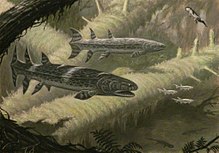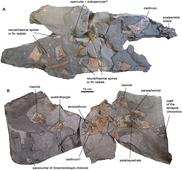Hyneria
| Hyneria Temporal range:
| |
|---|---|

| |
| Life restoration of H. lindae | |

| |
| Skull reconstruction of H. uldezinye | |
| Scientific classification | |
| Domain: | Eukaryota |
| Kingdom: | Animalia |
| Phylum: | Chordata |
| Clade: | Sarcopterygii |
| Clade: | Tetrapodomorpha |
| Clade: | Eotetrapodiformes |
| Family: | †Tristichopteridae |
| Genus: | †Hyneria Thomson, 1968 |
| Type species | |
| †Hyneria lindae Thomson, 1968
| |
| Other species | |
| |
Hyneria is a genus of large
Etymology
The genus name Hyneria is a reference to the village of Hyner, Pennsylvania, near where the first specimen was found. The species epithet H. lindae is derived from the name of the wife of Keith Stewart Thomson, who described this fish.[3]
Description
Hyneria was a large fish. H. lindae is estimated around 2.5–3 metres (8.2–9.8 ft) in total length.neotenic.[9]
Discovery

The original fossils came from two localities in Pennsylvania, United States, one found between the villages of North Bend and Hyner and another near
Catskill Formation of the Red Hill Shale, dating to the upper Devonian.[1] These were the only remains known until 1993 when a renewed collecting effort discovered abundant new material.[1] Hyneria is considered the largest and most common lobe-finned fish found in the Red Hill Shale.[10] In February 2023 a second species of Hyneria, H. udlezinye, was named from remains discovered in the Waterloo Farm lagerstätte. These remains include the skull and shoulder girdle.[2]
References
- ^ .
- ^ PMID 36812170.
- ^ a b c d Thomson, K. S. (1968). "A new Devonian fish (Crossopterygii: Rhipidistia) considered in relation to the origin of the Amphibia". Postilla. 124.
- S2CID 89661336.
- PMID 23483884.
- ISSN 1424-2818.
- S2CID 211122587.
- ^ a b "25 years of fossil collecting yields clearest picture of extinct 12-foot aquatic predator". ScienceDaily. 7 May 2018.
- S2CID 134090370.
- .
External links
- Hyneria at Devonian Times
